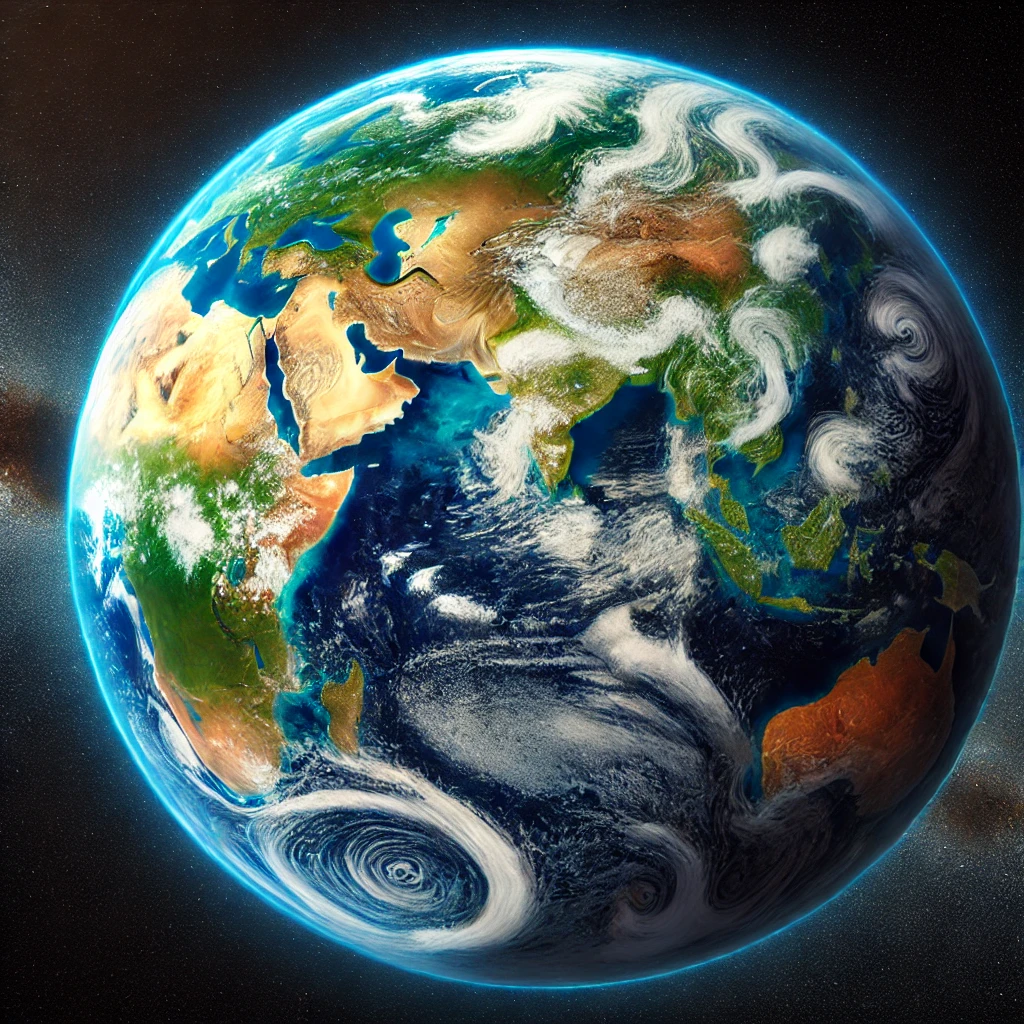Greetings, Earthlings! Captain Nova here, reporting from the Odyssey Explorer on Day 6 of our “100 Days of Space Exploration” journey. Today, we’re coming back to where it all began: Earth. The only planet we know to harbor life, Earth is a beacon of hope and a reminder of the delicate balance required to sustain life. Let’s take a deep dive into the wonders of our home in space.

Earth: An Overview
Earth, the third planet from the Sun, is a dynamic and vibrant world. With its diverse ecosystems, flowing water, and protective atmosphere, it is uniquely suited for life as we know it.
Here are some quick facts about Earth:
- Diameter: Approximately 12,742 kilometers (7,918 miles).
- Distance from the Sun: About 149.6 million kilometers (93 million miles), a distance known as 1 Astronomical Unit (AU).
- Orbital Period: 365.25 days.
- Rotation Period: 24 hours.
- Surface Composition: 71% water and 29% land.
Earth’s perfect position in the Solar System—often called the “Goldilocks Zone”—ensures that it’s neither too hot nor too cold, allowing liquid water to exist on its surface. This liquid water is essential for life and plays a significant role in regulating Earth’s climate.
Earth’s Layers: A World Beneath Our Feet
Our planet is composed of several layers, each with unique properties:
- Crust: The outermost layer, consisting of continents and ocean floors. It’s relatively thin, ranging from 5 to 70 kilometers (3 to 43 miles) thick.
- Mantle: Beneath the crust lies the mantle, a layer of semi-solid rock that slowly flows over millions of years, driving plate tectonics.
- Outer Core: Composed of molten iron and nickel, the outer core generates Earth’s magnetic field through its motion.
- Inner Core: A solid sphere of iron and nickel, with temperatures reaching up to 5,700°C (10,300°F).
These layers work together to shape Earth’s surface, from forming mountains and volcanoes to creating fertile soils that support life.
Earth’s Atmosphere: A Protective Shield
Earth’s atmosphere is a delicate mix of gases that shields us from harmful solar radiation and cosmic debris. It’s composed primarily of:
- Nitrogen: 78%
- Oxygen: 21%
- Other Gases: 1% (including carbon dioxide, argon, and water vapor)
The atmosphere is divided into several layers:
- Troposphere: The lowest layer, where weather occurs and where most life exists.
- Stratosphere: Contains the ozone layer, which absorbs harmful UV radiation.
- Mesosphere: Protects Earth by burning up meteoroids.
- Thermosphere: A region of high temperatures, home to the auroras and the International Space Station.
- Exosphere: The outermost layer, where Earth’s atmosphere transitions into space.
Earth’s Magnetic Field: A Guardian in Space
Generated by the motion of molten iron in the outer core, Earth’s magnetic field acts as a shield against the solar wind, a stream of charged particles emitted by the Sun. Without this protective barrier, the solar wind would strip away our atmosphere, as it has on Mars. The magnetic field also creates stunning auroras when charged particles interact with atmospheric gases.
Water: The Lifeblood of Earth
Water is the defining feature of Earth, covering over 70% of its surface. It exists in three states—liquid, solid, and gas—and moves through the hydrological cycle, which includes evaporation, condensation, and precipitation. This cycle not only regulates Earth’s temperature but also sustains ecosystems and supports agriculture.
Earth’s Biosphere: A Tapestry of Life
Earth’s biosphere is a complex web of life, ranging from microscopic bacteria to towering redwood trees and blue whales. Life exists in every corner of our planet, from the deepest ocean trenches to the highest mountain peaks.
Key Ecosystems:
- Forests: Lungs of the planet, producing oxygen and storing carbon.
- Oceans: Covering 71% of Earth’s surface, they regulate climate and are home to countless species.
- Deserts: Harsh yet vibrant ecosystems, home to unique adaptations.
- Polar Regions: Crucial for reflecting sunlight and regulating global temperatures.
Earth’s biodiversity is both a marvel and a responsibility. Every species plays a role in maintaining the balance of ecosystems, and it’s up to us to protect this fragile web of life.
Earth’s Climate: A Delicate Balance
Earth’s climate is driven by the Sun and regulated by the atmosphere, oceans, and living organisms. The greenhouse effect—where gases like carbon dioxide and methane trap heat—keeps Earth warm enough to support life. However, human activities like burning fossil fuels and deforestation are intensifying this effect, leading to global warming and climate change.
Exploring Earth from Space
From space, Earth is a stunning blue marble, its beauty amplified by swirling clouds, shimmering oceans, and verdant continents. Observing Earth from orbit has provided invaluable insights into weather patterns, natural disasters, and environmental changes.
Satellites like NASA’s Earth Observing System and the European Space Agency’s Copernicus program continuously monitor our planet, helping us understand and address challenges like climate change, deforestation, and pollution.
A Precious Planet
As I gaze at Earth from the Odyssey Explorer, I’m reminded of its uniqueness and fragility. Despite being one of billions of planets in the universe, Earth is our only home. Its delicate balance of air, water, and life is a cosmic miracle, one that we must cherish and protect.
Tomorrow, we’ll stay close and talk about Earth’s faithful companion, the Moon. Together, we’ll uncover its mysteries and explore its impact on life and culture. Until then, let’s take a moment to appreciate the extraordinary world we call home.
Stay curious,
Captain Nova
Odyssey Explorer
Leave a Reply